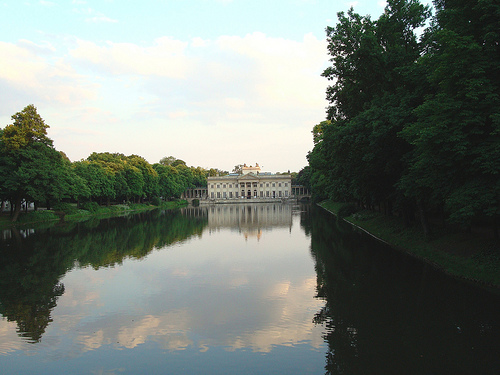

Location: Lazienki Krolewskie, ul. Angrykola 1 Map
Tel. 022 506 01 01
Bus: 108, 116, 138, 166, 180, 187, 195, 503
Park: Open: daily until dusk
Palace on the Water: Open: 9am- 4pm Tue- Sun
Łazienki or Lazenkovsky Palace (Polish: pałac
Łazienkowski; also the Palace on the Water and the Palace on the
Island) is a small chamber residence of the last Polish king
Stanislav Poniatowski on an artificial island in Warsaw's
Lazenkovsky Park, built for him by the project of Domenico Merlini
in the style of early classicism in 1784-1795 on the basis of the
bathhouse of the princes of Lyubomirsky (architect Tilman of Gamer,
1683–1690). The interiors of the palace with paintings by Rembrandt
and Rubens were completely destroyed during the Second World War.
Restoration work was completed in 1964.
Initially, the
building was built as a bathhouse for Stanislav Irakli Lyubomirsky,
the owner of the adjacent Uyazdovsky castle. After 1678, the
Łazienki palace
complex was expanded with four park pavilions: Arcadia, the
Hermitage, Frascati and the largest of them Banya. The marble
building was built in 1683-1689 according to the design of Tilman
Gamersky and was intended as a bathhouse, inhabited pavilion and
garden grotto. The interiors of the newly built structure were
adorned with abundant stucco moldings, also designed by Tilman van
Gameren. Among the decorations were water deities (for example,
Nereus) that surrounded the main decorative feature of the pavilion
- the fountain. In other halls there were richly decorated plafonds
and desuportes, and the walls were covered with Delft tiles. Facades
and interiors were decorated with sculptures, reliefs, Latin
inscriptions and the coat of arms of Lubomirsky.
King Stanislav II decided to transform
the pavilion into private premises, and it was rebuilt by Domenico
Merlini between 1764 and 1795. During World War II, the Germans
drilled holes in the walls for explosives, but could not destroy the
palace. Subsequently, the palace served as a barracks.
The Łazienki palace is built on an artificial island that divides the lake into two parts - a smaller northern lake and a larger southern one. The palace is connected to the surrounding park by two ionic colonnade bridges. The facades are united by an entablature, supported by giant Corinthian pilasters, which combine two floors and are crowned with a balustrade that carries statues of mythological figures. The northern facade is decorated with a central portico with a pediment. On the southern facade, a deep central niche is located behind a number of Corinthian columns.
On the ground floor of the palace is Bacchus’s
room, decorated with Dutch blue tiles of the 17th century and a
painting by Jacob Jordaens depicting Silenus and Bacchanas. The 1778
ceiling painting “Bacchus, Ceres, Venus and Cupid” by Jan Bogumil
Plersha was burned by German troops in 1944. The rotunda designed by
Domenico Merlini occupies the central part of the palace. Decorated
with yellow and white marble, with portraits of Polish kings, this
is one of the most important examples of neoclassical decoration in
the palace. It leads to the bathroom and ballrooms. On the other
side of the rotunda is the lower art gallery, which presents the
works of Rubens and Rembrandt and the chapel. Also on the ground
floor there is a dining room where the famous Thursdays dinners were
held, to which King Stanislav Augustus invited famous masons and
connoisseurs of Polish Enlightenment.
Solomon’s room, one of
the largest on the first floor of the palace, was decorated with a
series of paintings depicting the story of King Solomon. It
consisted of six paintings: The Dream of Solomon (ceiling), The
Queen of Sheba before Solomon, The Condemnation of Solomon,
Consultation with King Hiram (frieze), Dedication to the Temple, and
The Victim of Solomon (walls). They were performed for King
Stanislav Augustus in 1791-1793 by Marcello Baccarelli and depicted
the monarch himself in the form of a biblical king. All these
paintings were deliberately and completely destroyed by the Germans
in 1944 (burned in the fire in front of the palace) in preparation
for the explosion of the building.
On the second floor there
is an upper art gallery, a balcony room, a royal office, royal
bedrooms, a dressing room and a guard room.